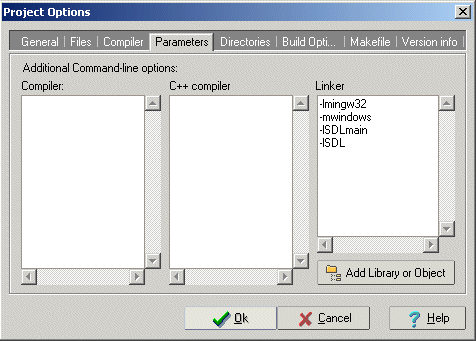Last Updated 2/18/12
In this tutorial you're going to learn to set up SDL_image. If you know how to set up this extension, you can set any of them up.SDL_image is located on this page.
Also, always make sure that when you get an SDL extension (SDL_image, SDL_ttf, SDL_mixer, etc) that you also get the newest version of SDL.New versions of the SDL extensions don't like old versions of SDL.If you don't, Dev C++ will compile the program but the program will complain at run time (it's typically something about an entry point).
Oct 29, 2018 # sdl # c # cpp. Noah11012 Oct 29, 2018 ・. This is the first article I've written on Dev.to so I'm new to this and I'm not sure how this series will be. Development Libraries: Windows: SDL2-devel-2.0.14-VC.zip (Visual C 32/64-bit) SDL2-devel-2.0.14-mingw.tar.gz (MinGW 32/64-bit) Mac OS X: SDL2-2.0.14.dmg. Wii u emulator download mac. Linux: Please contact your distribution maintainer for updates. Now we are done with the setup and can therefore start using SDL2 for development in C/C, so I will include some example code to get a basic object moving on the screen. Here is platformer.c! For more Game development in C: Writing 2D Games in C using SDL by Thomas Lively. Download driver pack 14 full isoenergybenefits.
Every extension libary has 3 essential parts:- The header file.
- The lib file.
- The *.dll file(s)
Open up the zip archive and there should be a folder inside.
Open the folder and it'll contain 2 subfolders.
2)First, open the include subfolder in the archive and you should seea header file. Put that header file in the directory with all the other header files in the SDL folder youextracted in lesson 1.
For example, I extracted the SDL version 1.2.12 folder to 'C:', so I put the SDL_image.h (or SDL_ttf.h orSDL_mixer.h) header in C:SDL-1.2.12includeSDL.
3)Now find the lib folder from the archive. Take the library file(s) from the archive and put them with the rest of the SDL library files.In my case the rest of the SDL library files were in C:SDL-1.2.12lib.
For certain versions of SDL_image, there will be a x86 folder and a x64 folder inside of the lib folder from the archive. The x86 folder contains the 32bit *.lib filesand the x64 bit folder contains the 64bit versions of the library files. If you're compiling a 32bit program, copy the library file(s) from the x86 folder and if you'recompiling a 64bit version copy the library file(s) from the x64 folder. By default most compilers compile in 32bit so if you're not sure how you're compiling, try the 32bitlibraries first. What matters here is not whether you have 32/64bit windows, but what type of program you're compiling.
C Sdl With Dev C C++
If you don't see a x86 or x64 folder inside of the lib directory from the archive, just copy the library file(s) from the lib folder from the archive.
4)Now extract all of the *.dll file(s) from the archive and put them inthe same directory as your exe.
C++ Sdl With Dev C++ Unicode
Like before, you can copy them to C:WINDOWSSYSTEM32 (or C:WindowsSysWOW64 on 64bit Windows) so your SDL appwill find the *.dll(s) even if they're not in the same directory. The problem with this method is if you havemultiple SDL apps that use different versions of SDL, you'll have version conflicts. If you have an old versionin SYSTEM32 when the app uses the new version you're going to run into problems. Generally you want to have yourthe *.dll(s) in the same directory as your executable developing and you'll always want to have *.dll(s) inthe same directory as the exe when distributing your app.

5)Now open up your SDL project and go to the project options.
6)Under the Parameters tab, paste:

-lSDL_image
in the linker after '-lmingw32 -lSDLmain -lSDL'.
If you were linking SDL_ttf you'd put
-lSDL_ttf
if you were linking SDL_mixer you'd put-lSDL_mixer
etc, etc. 7)To use SDL_image make sure to include the header file.
7)To use SDL_image make sure to include the header file.#include 'SDL/SDL_image.h'
If you were setting up SDL_ttf you'd put
Now the extension library is all set up.
#include 'SDL/SDL_ttf.h'
If you were setting up SDL_mixer you'd put#include 'SDL/SDL_mixer.h'
etc, etc.Now the extension library is all set up.
Now you can use SDL_image functions.
The main one you want to know about is IMG_Load().
The main one you want to know about is IMG_Load().
SDL_Surface *load_image( std::string filename ) { //The image that's loaded SDL_Surface* loadedImage = NULL; //The optimized image that will be used SDL_Surface* optimizedImage = NULL; //Load the image using SDL_image loadedImage = IMG_Load( filename.c_str() ); //If the image loaded if( loadedImage != NULL ) { //Create an optimized image optimizedImage = SDL_DisplayFormat( loadedImage ); //Free the old image SDL_FreeSurface( loadedImage ); } //Return the optimized image return optimizedImage;}
Here is a revised version of the image loading function from the previous tutorial.As you can see IMG_Load() functions exactly the same as SDL_LoadBMP(), but there's one big exception:IMG_Load() can load BMP, PNM, XPM, LBM, PCX, GIF, JPEG, TGA and PNG files.
From this tutorial on, PNG image files will be the primary image format used. PNGs have excellent lossless compression.
From this tutorial on, PNG image files will be the primary image format used. PNGs have excellent lossless compression.
Download the media and source code for this tutorialhere.
I highly recommend that you download the documentation for SDL_image and keep it handy.
It can be found here.
Previous TutorialNext Tutorial
I highly recommend that you download the documentation for SDL_image and keep it handy.
It can be found here.
Previous TutorialNext Tutorial
